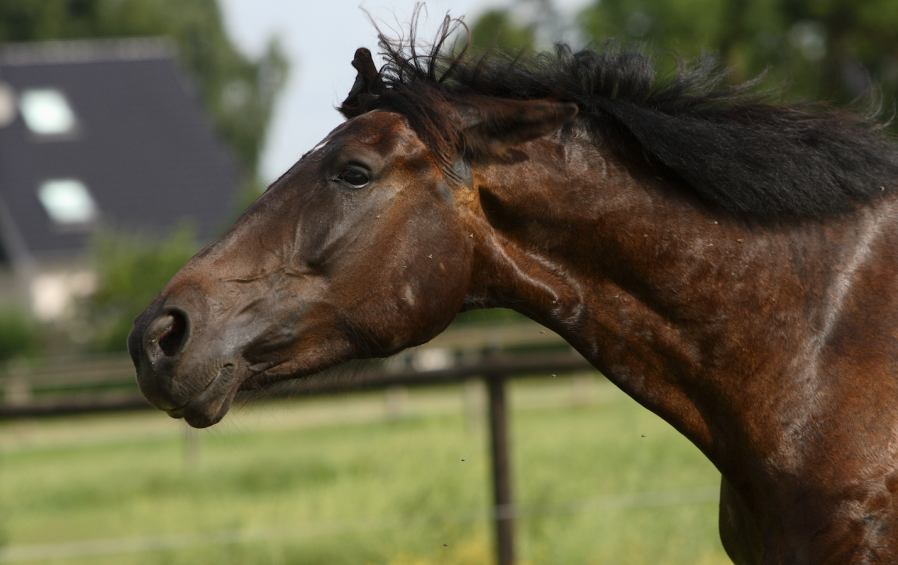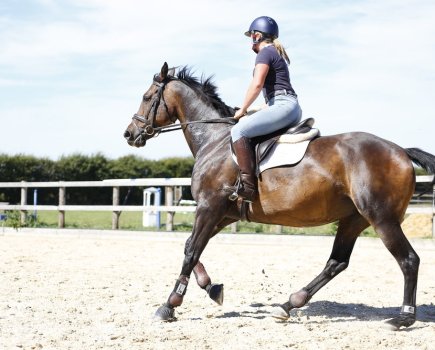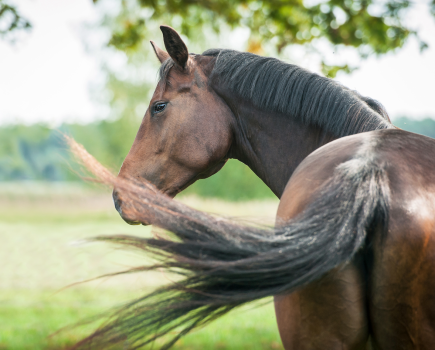Of course, it is normal behaviour for a horse to shake his or her head. However, one in 25 horses in the UK are reported by their owners to shake their heads more than is normal.
There are many reasons for horses to shake their heads too much, including ill-fitting tack, musculoskeletal pain and dental pain.
When this is the case you may be able to resolve the problem yourself or by involving paraprofessionals such as a saddler, trainer or physiotherapist — although it is my opinion that involving your vet early on can be beneficial.
A quarter of horses shake their head so badly, or do not get better, and these are the ones that do see a vet.
Of these, 90% will be diagnosed with trigeminal-mediated (TGM) head shaking in horses.
The vast majority of the remaining 10% have a better prognosis than those diagnosed with trigeminal-mediated headshaking and the underlying cause is successfully treated.
Trigeminal-mediated head shaking
There is some evidence that in TGM head shaking in horses, the main sensory nerve to the face has become some 10 times more sensitive than that of a normal horse.
We do not know how or why this sensitisation occurs.
There is a complex association between environment and sensitisation, but it is not allergy.
In fact, the nerve when examined under a microscope appears entirely normal, ruling out other proposed causes such as nerve damage from tack.
It is likely that the sensitisation results in nerve pain, which is called neuropathic pain.
People with neuropathic pain report varying occurrence and intensity of pins and needles, burning and electric shock-like pain.
We assume horses experience the same type of pain and indeed if you watch a horse with trigeminal-mediated headshaking, they look exactly like they are experiencing these sensations.
Clinical signs
TGM head shakers show varying intensity and frequency of predominantly vertical head shaking.
This is accompanied by sharp vertical tics and signs of nasal irritation, such as snorting, nose rubbing and striking at the nose with the front legs.
Types of horse affected
Horses are not born trigeminal-mediated head shakers, but instead acquire the condition, usually between the ages of about four and 12.
There does not seem to be direct heritability.
Seasonal influences
Some horses with trigeminal-mediated headshaking are affected all year round, though all TGM headshakers tend to vary moment on moment and day on day.
About 70% are much better in the autumn and winter, with 30% of those being clear of any signs at this time of year.
Less commonly, horses may only show signs when it is raining or just about to rain, for example.
Environmental riggers
Many TGM headshakers seem to have an environmental trigger(s), and these do appear to be individual.
For example, they may show signs more commonly on days with more sunlight or wind, or near particular hedges or trees.
It is hard to separate possible triggers, though, as days with more sun and wind may also have more particulates.
Moving environment only occasionally results in signs resolving, however.
Virtually all horses who head shake will be worse affected at exercise than rest. Those that are also affected at rest are of particular welfare concern, as they may have little relief from pain.
Diagnosing head shaking
The first step is to be as sure of a diagnosis as is possible. If the cause of the head shaking is, for example, an ill-fitting saddle or a lameness, then resolving that is the key to management.
A diagnosis of trigeminal-mediated head shaking is one of exclusion and ideally made by a vet using a range of tests, including a computed tomography (CT) scan of the head. This often requires referral to a specialist.
Once a diagnosis of trigeminal-mediated headshaking has been made, there are treatments that can be tried.
However, there is no one good treatment for all. Response can be very individual.
There are many unpublished treatments which may work well for some individuals but without scientific data behind them.
Owners risk spending a lot of time and money on unproven treatments, and all the while their horse is suffering.
Treatment
Unfortunately, we do not know how or why trigeminal-mediated head shaking occurs in horses and, until that happens, we do not know how to prevent it nor how best to treat it.
In the meantime, the following methods can be effective in managing and treating head shaking in horses:
Nose nets
The first treatment option is a nose net. These fall largely into three different types, and it is worth trying all three.
Some are allowed in some competitions and owners should check with their regulatory body.
It is thought that nose nets work by rubbing the nose – the same way that if you bang your elbow, you rub it and it feels less painful.
You can expect 25% of trigeminal-mediated headshakers to be up to 70% better with a nose net. You may achieve greater success by adding in a facemask.
It is much harder if your horse is in the 75% of non-responders to a nose net, or if 70% improvement is not enough.
Magnesium
You can supplement feeds with magnesium as part of a holistic approach. Magnesium calms nerve firing. However, most horses do not seem to show a dramatic improvement.
Use of magnesium has been found to reduce headshaking (Sheldon et al, 2019 B; Sheldon et al, 2019 C).
The work was carried out in the USA where they used magnesium with boron.
Boron increases uptake of magnesium but cannot be fed in the UK. However, boron itself is not the active ingredient.
There are other pharmaceuticals to try, however, response is very individual, they can be very expensive, may have side effects, such as sleepiness, and are not allowed in competition.
EquiPENS™ neuromodulation
A pharmaceutical trial is something to discuss with your vet.
EquiPENS™ neuromodulation gives 50% of horses remission after three hospital-based procedures.
They return to ridden work at the previous level, however, this is for an unpredictable period of time.
Risks are low, but present, and it is expensive. However, it is currently the best treatment available where a nose net is ineffective.
Results from EquiPENS™ neuromodulation, developed by myself in collaboration with others, was also published in a large international study (Roberts et al, 2020).
Avoiding triggers
If you know your horse’s triggers very well and they are specific, then sometimes it is possible to avoid them.
However, this is fairly rare and I wouldn’t advocate against owners turning their lives upside down — for example staying close to home to be able to bring their horse in from the field at the first sign of rain — as this causes huge amounts of anxiety and difficulty.
Triggers of head shaking
There are many causes of head shaking in horses, including musculoskeletal pain, cervical (neck) pathology and temporomandibular joint (jaw joint) pathology.
One top-level dressage horse who was referred to me had started to head shake. It was worse at exercise and he was no better on ‘bute or with rest.
After several months of trying to find a solution, his owner brought the horse to see us.
We found on CT scan that he had broken a fragment of bone from his top neck vertebra — and no one knows how on earth he did it.
It had been there for some months, which limited treatment options, added to the fact that this is not really a diagnosis found in a textbook.
We injected steroid around the fragment to settle inflammation and the horse did lots of physiotherapy.
A special bridle was made for him and I was delighted when he returned to competing.
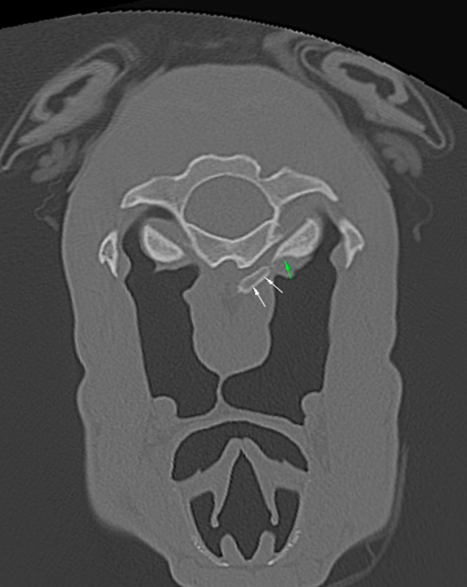
Latest research
There have been 18 peer-reviewed papers over the last five years on trigeminal-mediated head shaking in horses, showing it is an active research area.
A survey of cases in Germany, Australia and then France and Switzerland found the situation similar to US and UK, where most research has been published (Maxi Stange et al, 2020; Maxi Stange et al, 2022; Bell et al, 2024).
The caecal microbiome of TGM head shakers differs to that of horses with orthopaedic disease, although it is not clear if this is cause, result or association (Aleman et al 2022).
Seasonally affected geldings did not have different levels of a hormone, compared to healthy geldings in late summer, so this did not explain a cause (Sheldon et al, 2019 A).
My own research
I have been involved in a study to demonstrate that cannabinoid receptors are expressed in the trigeminal ganglion of the horse, and we are doing further work in this area (Zamith Cunha et al, 2023).
I’ve also been working to develop an objective measure (like a ‘FitBit’), which has been shown to be an accurate measure (Pickles et al, 2024) and is being further developed, as well as a novel scoring system (Kloock et al, 2024 A; Kloock et al, 2024 B).
Besides this, I am part of a research team showing the importance of computed tomography in making a diagnosis (Fairburn et al, 2023; Perrier at el, 2023; Kloock et al, 2022; Edwards et al, 2019).
If your horse starts head shaking
If head shaking comes on suddenly and your horse is affected at rest, please call your vet urgently.
When this is not the case, first gather some information and take some videos of your horse in the stable, field, lunging and ridden (if safe to do so).
Try using a nosenet to see if it helps alleviate symptoms and then contact your vet with the information you have gathered.
I am lucky enough to work with great horses, owners, referring vets, veterinary and research teams.
We have had great successes, getting anything from international competition horses through to children’s ponies back to work.
Sadly, however, it is the failures which we remember more prominently. Until we know the cause of trigeminal-mediated head shaking we will always struggle to treat it and have no idea how to prevent it.
To make progress, we need more research.
- The Langford Trust for Animal Health and Welfare have a dedicated fund for head shaking research. Here is a link for further information and should you be interested in donating.
My patients
‘His triggers aren’t consistent’
I diagnosed a beautiful horse called Jack with trigeminal-mediated headshaking.
His owner, Mel, is a veterinary nurse and extremely dedicated, but despite our best efforts, Jack’s TGM headshaking did not responded to any treatment.
Jack was subsequently retired, and Mel very kindly allows him to participate in our (ethically approved) research.
“Head shaking is a frustrating, painful condition that has many triggers which sadly are never consistently the same,” says Mel.
“One day the rain or hay may cause an attack, but later that same day at a different time there may be no reaction at all.
“This makes it so difficult to treat and find a solution. However, with more research and information given by owners of head shaking horses we can further our bank of knowledge and give us a further insight into finding the answer.”
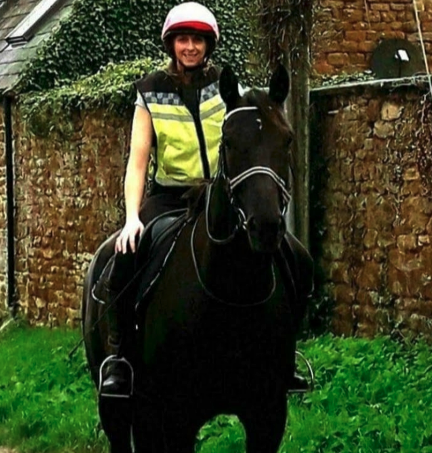
EquiPENS made all the difference
Although I have seen hundreds of horses for head shaking investigation, Dude stands out because of his awesome personality and his dedicated owner.
Dude was diagnosed with TGM head shaking and was one of the first horses in the world to try EquiPENS ™ neuromodulation some 10 years ago.
Amy, his amazing owner, put all faith in us and travelled him from Durham to Bristol on several occasions to be part of our first treatment trial.
During that time, Dude even managed to break a leg.
He survived, but he did have to start treatment all over again. Dude is still in ridden work today.
“The best thing I ever did was accidentally stumble on Veronica and her PENS therapy study,” says Amy.
“Dude had just been diagnosed as a head shaker and the prognosis was bleak.
“I found the study and emailed not expecting a reply, but Ronnie responded the same day and not long after we made the journey to Bristol.
“Dude’s been in remission for 10 years now and continues to do everything we did prior to the diagnosis,” adds Amy.
“Without EquiPENS™ I don’t think he would have seen the last 10 years. I’m forever grateful to Ronnie for giving Dude and I this life.”
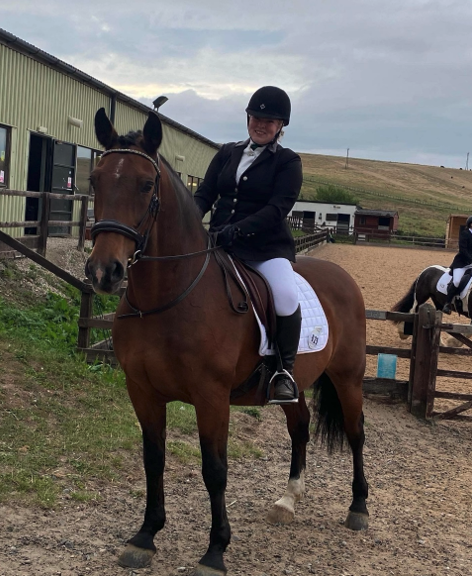
Related content
- Resistance to antibiotics is growing and this is what we need to do about it
- How to tell if a horse is happy
- Can you read your horse’s body language?
- This is what horse ear positions mean
- How to lower the risk of equine flu
References
Aleman M., Sheldon S.A., Jospin G., Coil D., Stratton-Phelps M., Eisen J. (2022) Caecal microbiota in horses with trigeminal-mediated headshaking Vet Med Sci 8(3):1049-1055
Bell T., Kyriazopoulou P, Mowbray C., Murphy B.A. (2024) Equine Headshaking Syndrome: Triggers, Seasonality, and Treatment Efficacy in Australia. Animals (Basel) 13;14(6):875
Edwards RA, Hermans H, Veraa S. (2019) Morphological variations of the infraorbital canal during CT has limited association with headshaking in horses. Vet Radiol Ultrasound. 60(5):485-492
Fairburn A.J., Meehan L.J. , Roberts V.L.H (2023) Computed tomographic findings in 101 horses presented for the investigation of headshaking. Equine Vet Edu. 35;4:339-345
Kloock T, Pickles KJ, Roberts V, Uhlendorf F, Twele L, Wilkens HL, Stehle E, Feige K, Niebuhr T. (2024) History, Rest and Exercise Score (HRE-S) for assessment of disease severity in horses with trigeminal-mediated headshaking. Equine Vet J. 56(3):464-474
Kloock T, Hellige M, Kloock A, Feige K, Niebuhr T. (2024, B)Application of the HRE-S to 140 horses with trigeminal-mediated headshaking and the association of clinical signs with diagnosis, therapy, and outcome. Front Vet Sci. 5;11:1329054
Kloock T, Hellige M, Kloock A, Feige K, Niebuhr T. (2022) Impact of Different Diagnostic Procedures on Diagnosis, Therapy, and Outcome in Horses with Headshaking: Recommendations for Fast-Track Advanced Diagnostic and Therapeutic Protocols. Animals (Basel) 13;12(22):3125
Maxi Stange L., Krieter J., Czycholl I. (2022) Comparison of the Current Situation of Equine Headshaking Syndrome in France and Switzerland Based on an Online Survey. Animals (Basel) 28;12(11):1393
Maxi Stange L, Krieter J., Czycholl I. (2020) Overview of the Current Situation in a Sample of Headshakers and Owner Assessment of Effective Therapeutic Measures Used in Germany. J Equine Vet Sci 95:103270
Perrier M, Manso-Díaz G, Dunkel B (2023) Computed tomography findings in horses presented with signs of head-shaking Equine Vet Journal. 55(4):649-655
Pickles K, Williams J, Marlin D, Roberts V (2024) Use of a poll-mounted accelerometer for quantification and characterisation of equine trigeminal-mediated headshaking Equine Vet Journal. In press.
Sheldon SA., Aleman M., Rosa R Costa L., Santoyo A.C, Weich K.M, Howey Q., Madigan J.E (2019 – A) Luteinizing hormone concentrations in healthy horses and horses with trigeminal-mediated headshaking over an 8-hour period. J Vet Intern Med 33(2):885-888
Sheldon SA, Aleman M, Costa LRR, Santoyo AC, Howey Q, Madigan JE. (2019 -B) Intravenous infusion of magnesium sulfate and its effect on horses with trigeminal-mediated headshaking. J Vet Intern Med. 2019 Mar;33(2):923-932
Sheldon SA, Aleman M, Costa LRR, Weich K, Howey Q, Madigan JE. (2019 – C) Effects of magnesium with or without boron on headshaking behavior in horses with trigeminal-mediated headshaking. J Vet Intern Med. 2019 May;33(3):1464-1472
Roberts VLH, Bailey M; Equipens™ group; Patel NK. (2020) The safety and efficacy of neuromodulation using percutaneous electrical nerve stimulation for the management of trigeminal-mediated headshaking in 168 horses. Equine Vet J. 2020 Mar;52(2):238-243
Zamith Cunha R, Semprini A, Salamanca G, Gobbo F, Morini M, Pickles KJ, Roberts V, Chiocchetti R. (2023) Expression of Cannabinoid Receptors in the Trigeminal Ganglion of the Horse. Int J Mol Sci. 3;24(21):15949

